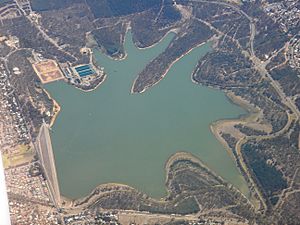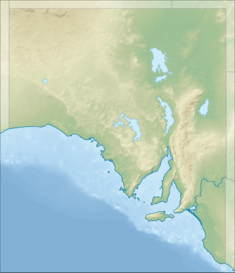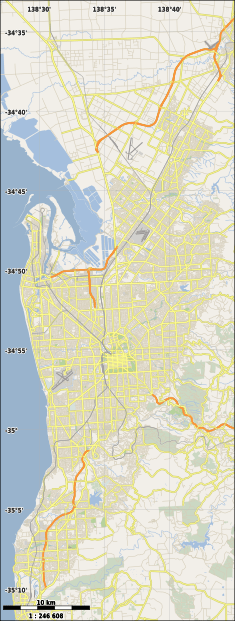Happy Valley Reservoir facts for kids
Quick facts for kids Happy Valley Reservoir |
|
|---|---|

Aerial view of Happy Valley Reservoir in early 2007
|
|
|
Location of Happy Valley Reservoir in Australia South Australia#Australia Greater Adelaide
|
|
| Country | Australia |
| Location | South Australia |
| Coordinates | 35°04′23″S 138°34′19″E / 35.073°S 138.572°E |
| Purpose | Reservoir |
| Construction began | 1892 |
| Opening date | 1897 |
| Construction cost | A$1.8 million |
| Dam and spillways | |
| Type of dam | Earth with clay core |
| Height | 23.6 metres (77 ft) |
| Length | 1,155 metres (3,789 ft) |
| Reservoir | |
| Total capacity | 11.5 gigalitres (410,000,000 cu ft) |
| Surface area | 1.88 km2 (0.73 sq mi) |
The Happy Valley Reservoir is a large water storage area located in Adelaide, South Australia. It was built a long time ago, between 1892 and 1897. Back then, Adelaide had about 315,200 people. Today, this reservoir helps supply water to over half a million people in Adelaide. It also provides a home for lots of Australian wildlife, like kangaroos.
Contents
Building the Reservoir: A Big Project
The Happy Valley Reservoir was built between 1892 and 1897. It cost about A$1.8 million, which was a lot of money back then! It was the third reservoir built in South Australia. The other two were the Thorndon Park Reservoir (built in 1860) and the Hope Valley Reservoir (built in 1872).
Moving a Town for Water
Building the new reservoir meant that the original Happy Valley town had to be moved. This included the school and even the cemetery. The town was relocated to the east. The cemetery, which is still used today, was moved to the west. It now sits near the base of the dam wall.
The old school was on Candy Road. It was moved south to Red Hill Road. A local farmer named Harry Mason gave two acres of land for the new school. The Happy Valley school was closed for 18 months. Some students went to other schools, but some had to wait until it reopened. The new school opened on September 26, 1898. It closed in 1979 and reopened on a new site across the road.
How Water Gets In
The reservoir works like a big 'holding pond' for water. Water comes from the Clarendon Weir through a long tunnel. This tunnel is five kilometers long and 1.8 meters wide. Workers dug it from both ends at the same time. When they met in the middle, they were only 25 millimeters off! The deepest part of the tunnel is 122 meters underground.
On August 7, 1896, the tunnel's inlet valve was opened. This was done by the Governor of South Australia, Sir Thomas Buxton, 3rd Baronet. That's when the reservoir started to fill up with water.
Happy Valley Reservoir Today
When it was first built, the reservoir was 15 kilometers from Adelaide. Now, the city's southern suburbs have grown around it. The relocated Happy Valley village is now one of these suburbs.
The Happy Valley Reservoir is not the biggest reservoir in Adelaide. It holds 11,500 megalitres of water. The Mount Bold Reservoir is much larger, about four times bigger. However, Happy Valley is very important. It has the largest water treatment plant in Adelaide. This plant cleans and provides over 40% of the city's water.
Wildlife and Nature
People are not allowed to access the reservoir area. This means the natural "bush" around it is safe for wildlife. You can find kangaroos, echidnas, and koalas living there.
Some areas also have pine plantations. These trees help stop soil from washing away. They also provide income when they are harvested. These pine forests have become a well-known sight in the suburbs. In the early 2000s, there were plans to cut down the mature pines. But people protested because they didn't want the view to change. So, the plans were stopped.
Water Delivery System
Water from the dam first went to Adelaide through a tunnel under Black Road. In the early 1960s, the tunnel from the Clarendon Weir was made bigger. This allowed maintenance vehicles to drive inside it. A second outlet tunnel was also built under South Road. In 1986, this new tunnel became the only way water left the reservoir. The old outlet was no longer used. Around the same time, the Thorndon Park Reservoir was turned into a park for people to enjoy.
Upgrading the Reservoir
Between 2002 and 2004, the Happy Valley Reservoir had a big renovation. This A$22 million project aimed to make the reservoir safer and better. It followed international and national guidelines for dam management.
Making the Dam Safer
The earth wall of the reservoir was at risk of "piping failure." This is when a small leak can grow bigger and cause the dam to collapse. The renovations greatly reduced this risk. The chance of the dam wall failing went from 1 in 1,200 to about 1 in 100,000.
The dam wall was also upgraded to hold more floodwater. This increased its flood storage capacity by 165%. It also made the dam stronger against earthquakes.
Discovering the Old Town
During the renovations, the water level was lowered. For the first time, the original Happy Valley township was visible again. Archaeologists took this chance to dig and explore the site. The town was completely intact when it was flooded in 1896. However, archaeologists found very little. They mostly found scattered bricks and the foundations of a few buildings. Only the Post Office was clearly identified.
- Capacity: 11.5 Gigalitres (that's 11.5 billion liters!)
- Length of wall: 1,155 meters
- Height of wall: 23.6 meters
- Type of wall: Earth with a clay core
- Area of water spread: 1.88 square kilometers



